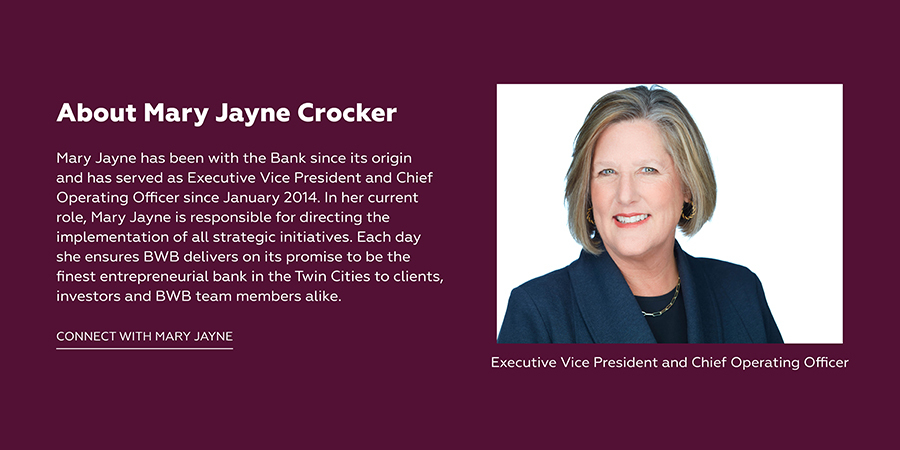
Boost Your Business’s Efficiency with Effective Meetings
By Mary Jayne Crocker, Executive Vice President & Chief Operating Officer at Bridgewater Bank
As many of us can affirm, there are few things more satisfying than productive meetings. Yet, it likely comes as no surprise to you, that the average American worker sits through 31 hours of ineffective meetings each month, costing U.S. companies an alarming $400 billion annually.
As business leaders, we can help reverse this trend by making meeting efficiency a company norm. Effective meetings allow you to focus on what really matters -- growing your business and serving your clients. Yet, it can be easier said than done. Here are some best practices we’ve found to be helpful:
Perform a Meeting Audit
When was the last time you and your team audited your list of meetings? Are each of your meetings necessary? Are they effective and efficient? If not, speak up.
This allows those not required in a meeting to focus their efforts on other business or client needs and contributes to a more focused and efficient meeting overall.
Set Clear Expectations Around Time
If starting and ending on time is the expectation, the discussion will be more focused and items with the highest priority will naturally get more attention.
Also, if a meeting doesn’t take the full time, don’t be afraid to end early. Use this valuable time to get started on to-dos.
Use a Quality Agenda Template
At Bridgewater, we often use agenda templates created by the Entrepreneurial Operating System (EOS) that provide structure, consistency, and accountability and set expectations.
For example, we begin each weekly departmental (Level 10) meeting by sharing personal and business bests, followed by cascading messages, and employee and vendor headlines. We then give a rapid status report of our trimester long projects, cover to-dos from the last week, and use the last portion of the meeting to “IDS,” meaning identify, discuss, and solve issues.
Although agendas this specific are not needed for every meeting, this format helps guide the way we view meetings.
Develop a Process for Discussing Agenda Items
A process helps keep the meeting moving. For example, when someone brings up an issue in our Level 10 meetings, we add it to the issues list to be discussed at the end, rather than interrupting the flow of the meeting.
This pre-determined process also keeps meeting leaders from having to determine whether a topic warrants discussion at that very moment.
Recap To-Do Items
Having everyone share their to-dos from the meeting can go a long way in improving accountability.
Additionally, if this is a recurring meeting, get a head start on the next agenda by documenting those to-do items. This helps prevent deliverables from falling through the cracks.
Rate the Meeting
We’ve found it helpful to end meetings by rating them. We score our Level-10 meetings on a scale from 1 to 10. Always aiming to be at a “level 10,” hence the name, ensures that meetings are as effective and efficient as possible.
I’ve also been in meetings where we put up a hand and rate it on a scale of 1 to 5. There are many creative ways to do this, and the feedback can help create better meetings.
Leverage a System Like EOS
The Entrepreneurial Operating System (EOS) has greatly helped Bridgewater structure meetings. EOS’s variety of tools and concepts help businesses clarify, simplify, and achieve their vision.
It’s helped us stay lean and quick at Bridgewater Bank, even as the bank grew from an entrepreneur’s vision to the company it is today.
Entrepreneurs and business leaders who champion meeting efficiency will notice the benefits within their business and feel the effects themselves. More effective meetings will allow you and your team more time to support your clients and drive your company forward. It is a simple and effective way to boost your business’s efficiency.

